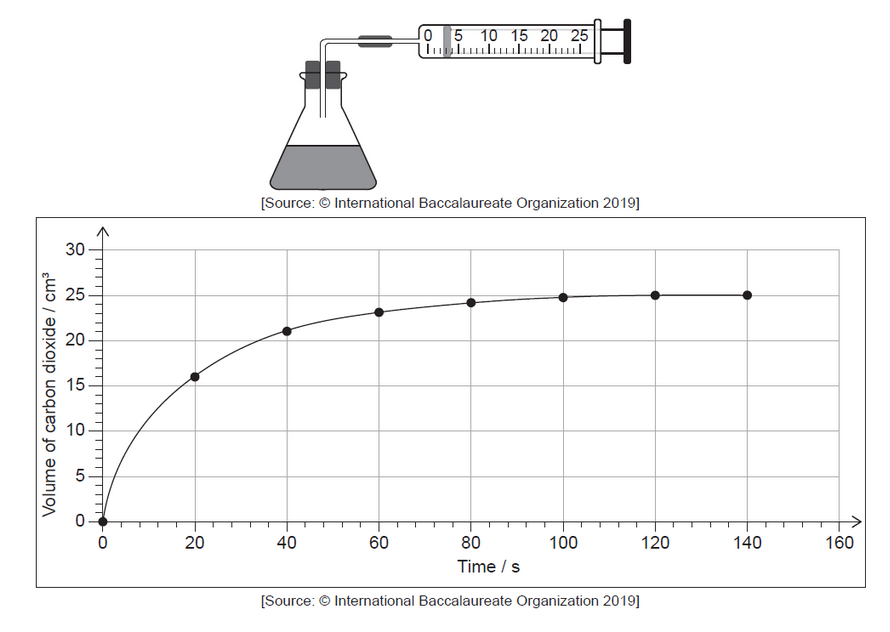Question
To investigate how much kale would supply the daily recommended intake of iron a student:
1 weighed 79.6g of kale leaves and blended with 500\(cm^3\) of water
2 boiled, filtered and cooled
3 pipetted 10.0\(cm^3\) of the filtrate into 20.0\(cm^3\) of 2.00mol \(dm^{-3}\) sulfuric acid in a flask
4 titrated with 0.00100mol \(dm^{-3}\) potassium manganate(VII).
The reaction taking place is:
\(5Fe^{2+}(aq) + MnO_4^-(aq) + 8H^+ (aq) → 5Fe^{3+}(aq) + Mn^{2+}(aq) + 4H_2O(l)\)
(a) All species are almost colourless except for \(MnO_4^-\), which has an intense purple colour, though the kale extract is coloured by the chlorophyll present.
(i) State the colour change at the end point.
From:
To:
(ii) Outline how the addition of distilled water to the 10.0\(cm^3\) aliquot before titration will affect the titrant volume at the end point.
(b) State the class of errors that always affect results in a particular direction.
(c) The end point occurred when 3.1 ± 0.1\(cm^3\) of the titrant had been added.
(i) Calculate the percentage uncertainty associated with the titre.
(ii) Suggest one procedural modification which would reduce the percentage uncertainty for a single titration, other than using a burette with greater precision.
(iii) The solution in the titration flask contained \(8.66 × 10^{-4}\) g of iron. Determine, to three significant figures, the percentage of iron, by mass, in the kale leaves.
(d) The value obtained is about 30 times greater than published values for the percentage of iron in kale. Suggest one reason, other than human error, why there might be such a large discrepancy.
Answer/Explanation
Answer:
(a) (i) green to purple
OR
green to brown
OR
green to purple-green
(ii) none / no effect
(b) systematic
(c) (i) ![]()
(ii) using more dilute potassium manganate(VII)
OR
using more dilute titrant
OR
larger aliquot/volume of filtrate
(iii) ALTERNATIVE 1
mass Fe in the 79.6 g kale 〈〈= \(8.66×10^{−4} \times \frac{500}{10.0}\)〉〉
= 0.0433 «g»
percent by mass 〈〈=\(\frac{0.0433}{49.6} \times 100\)〉〉
= 0.0544«%»
ALTERNATIVE 2
mass of kale in titration flask 〈〈=\(79.6 \times \frac{10.0}{500}\)〉〉
= 1.592 «g»
percent by mass 〈〈=\(\frac{8.66 \times 10^{-4}}{1.592} \times 100\) 〉〉
= 0.0544«%»
(d) other substances in the leaves «as well as iron» react with the manganate(VII)
«ion»
OR
kale modified to have more iron/Fe
OR
iron/Fe in water/pipes/container used for boiling
OR
manganate(VII) oxidized/reacted with other ions/substances/metals
OR
manganate(VII) concentration changes over time
Question
$$
\mathrm{Br}_2(\mathrm{aq})+\mathrm{HCOOH}(\mathrm{aq}) \rightarrow 2 \mathrm{Br}^{-}(\mathrm{aq})+2 \mathrm{H}^{+}(\mathrm{aq})+\mathrm{CO}_2(\mathrm{~g})
$$
The reaction was monitored by measuring the volume of carbon dioxide produced as time progressed.

a. Determine from the graph the rate of reaction at $20 \mathrm{~s}$, in $\mathrm{cm}^3 \mathrm{~s}^{-1}$, showing your working.
b. Outline, with a reason, another property that could be monitored to measure the rate of this reaction.
c(i)Describe one systematic error associated with the use of the gas syringe, and how the error affects the calculated rate.
c(ii)dentify one error associated with the use of an accurate stopwatch.
▶️Answer/Explanation
Markscheme
a. tangent drawn to curve at $\mathrm{t}=20 \mathrm{~s}[\boldsymbol{V}]$
slope/gradient calculation [ $\boldsymbol{V}]$
$0.35 \ll \mathrm{cm}^3 \mathrm{~s}^{-1} »[\boldsymbol{V}]$
Note: Accept values in the range $0.32-0.42 \ll \mathrm{cm}^3 \mathrm{~s}^{-1}$ 》
b. ALTERNATIVE 1
colour $[\boldsymbol{W}]$
$\mathrm{Br} 2$ /reactant is coloured «Br (aq) is not» $[\boldsymbol{V}]$
ALTERNATIVE 2
conductivity $[\boldsymbol{\sim}]$
greater/increased concentration of ions in products [ $\boldsymbol{V}]$
Note: Do not accept “changes in temperature” or “number of bubbles”.
ALTERNATIVE 3
mass/pressure $[\boldsymbol{\sim}]$
gas is evolved/produced $[\boldsymbol{\sim}]$
Note: Do not accept “mass of products is less than mass of reactants”.
ALTERNATIVE 4
$\mathrm{pH}[\boldsymbol{\varkappa}]$
methanoic acid is weak $A N D \mathrm{HBr}$ is strong
OR
increase in $\left[\mathrm{H}^{+}\right][\boldsymbol{V}]$
c(i) ALTERNATIVE 1
gas may leak/be lost/escape
OR
plunger may stick/friction «so pressure is greater than atmospheric pressure»
OR
syringe may be tilted «up» so plunger moves less «with gravity acting on plunger»
$O R$
$\mathrm{CO}_2$ dissolved in water $[\boldsymbol{W}]$
calculated rate lower $[\boldsymbol{V}]$
ALTERNATIVE 2
syringe may be tilted «down» so plunger moves more «with gravity acting on plunger»
OR
syringe is held in hand so gets warmer and gas expands $[\boldsymbol{V}]$
calculated rate higher $[\boldsymbol{\sim}]$
Note: Calculated rate is lower or higher must be stated for $M 2$.
Do not accept “scale on syringe is inaccurate”, “errors in reading syringe”, or “bubbles in syringe”.
c(iihuman reaction time/delay «starting/stopping the stopwatch» $[\boldsymbol{\sim}]$